#xerxes the great
Text
Florence Welch once said "hubris is a bitch" and I, Xerxes the great, really felt that
#tagamemnon#ancient history#xerxes#persian wars#xerxes i#xerxes the great#hellespontus#Herodotus#florence and the machine#Florence welch#music#100 years
78 notes
·
View notes
Photo

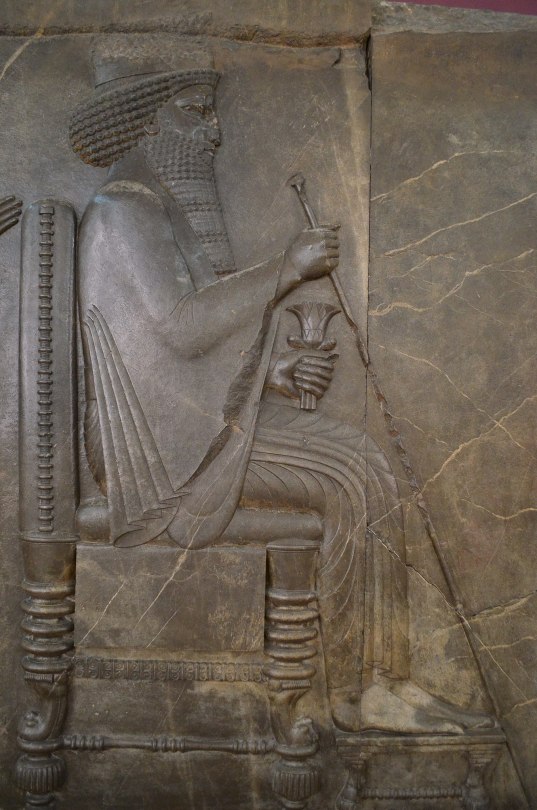
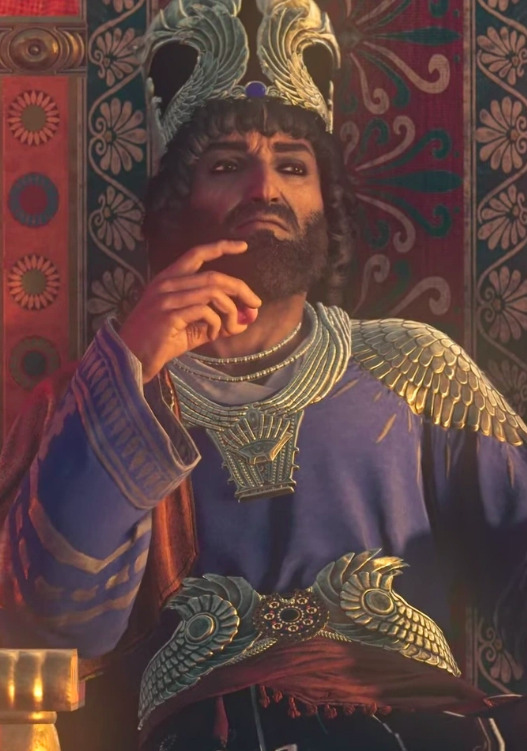

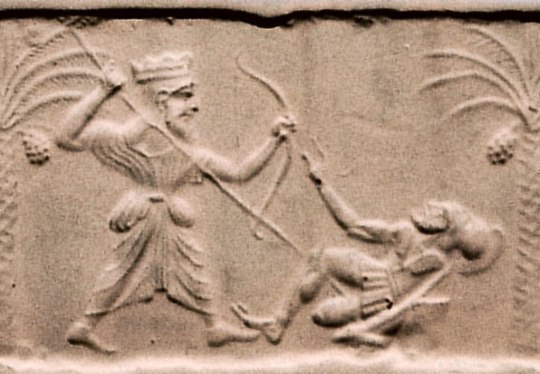
Ahasuerus, Haman and Esther by Rembrandt + National Museum of Iran Darafsh + Xerxes I of Persia + Go by John August (1999) + Achaemenid king killing a Greek hoplite. A possible depiction of Xerxes killing Leonidas
Thus we see how in that ancient Eastern time the Spiritual entered deeply into Nature, into all natural existence. But now we find also among these peoples something which to most of us in the present day may easily appear extremely barbarous. To a man of that time it would have appeared terribly barbarous if someone had been able to write in the feeling and attitude of mind in which we to-day are able to write; it would have seemed positively devilish to him. But when we to-day on the other hand see how it was accepted in those times as something quite natural and as a matter of course that a people should remove from West to East, should conquer — often with great cruelty — another people already in occupation and make slaves of them, then such a thing is bound to appear barbarous to very many of us.
This is, however, broadly speaking, the substance of oriental history over the whole of Asia. Whilst men had as I have described, a high spiritual conception of things, their external history ran its course in a series of conquests and enslavements. Undoubtedly that appears to many people as extremely barbarous. To-day, although wars of aggression do still sometimes occur, men have an uneasy conscience about them. And this is true even of those who support and defend such wars; they are not quite easy in their conscience.
In those times, however, man had a perfectly clear conscience as regards these wars of aggression, he felt that such conquest was willed of the Gods. The longing for peace, the love of peace, that arose later and spread over a large part of Asia, is really the product of a much later civilisation. The acquisition of land by conquest and the enslavement of its population is a salient feature of the early civilisation of Asia. The farther we go back into prehistoric times, the more do we find this kind of conquest going on. The conquests of Xerxes and others of his time were in truth but faint shadows of what went on in earlier ages.
—Rudolf Steiner, World History in the Light of Anthroposophy: Lecture II
After the Greeks had carried on the acquired treasures for some little while, the downfall of Greece occurred, and Rome took her place. In this way we should arrive at a plan of human evolution, so that when speaking of this plan we could never fall into the error of saying: ‘How did it come about, for instance, that just Xerxes or Miltiades or Leonidas had this or that individual karma?’ We must consider this individual karma as something which must be determined by and interwoven with the plan of the evolution of mankind. This cannot be understood in any other way; and this, too, is the view of Spiritual Science. But if this is the case, we must say: In this well-planned advance of human evolution we must see something which is a thing by itself, which is continuous in itself, in a similar way to that in which karmic events in individual human lives are connected with each other, and we must further enquire: ‘What relation does such a plan of the whole evolution of mankind bear to the individual karma of man?’
—Rudolf Steiner, Manifestations of Karma: Lecture XI
If we look with a sensitive eye at the felt relationship between man and man among the Ancient Greeks, and recognize how it has evolved from man's old relationship to the divine, we can say: what was previously an attitude permeated by religion has transformed itself into the legal attitude, the political attitude. Out of this, out of a combination of the nature of Greek and Roman, there then arose something that could maintain itself in social configurations. The priest gradually becomes merely the successor of the Oriental national leaders, for, although he may have kept himself in the background, the priest in the Orient was always the real spiritual leader, even with Darius and Xerxes. There comes to the fore a mode of thinking that cultivates ideas based on the relationship between man and man. And this goes so far that even religious life is swallowed up by this legal current, as I would call it. A juridical element enters man's world-picture, and even the cosmology of the time; and this element then remains almost throughout the Middle Ages and can be detected when we study the political views of, say, Augustine or Aquinas. Religious impulses themselves, while remaining what they are, take on legal forms.
—Rudolf Steiner, The Tension Between East and West: Lecture II
See more on the Kököchin–Barsine-Grail Knight individuality.
#Xerxes I#Xerxes the Great#Ahasuerus#The Book of Esther#Rembrandt#Assassin's Creed#Ancient Persia#Old Testament#spiritual science#anthroposophy#John August#Go (1999)#Sarah Polley#Kököchin#Barsine#the holy grail
4 notes
·
View notes
Text
#13 Book of Esther
Esther was married to Xerxes I – Xerxes the Great who ruled the Achaemenid Empire from 486 to 465 BC. He was also called King Ahasuerus. He was the son of King Darius and was born in 518 BC. The name Xerxes is pronounced ‘zerk zeez’.
The central purpose of this book is to record the institution of the annual festival of Purim as a Jewish festival, although it was only later that the Jews in…

View On WordPress
0 notes
Text
Countries that are no more: Achaemenid Empire (550BC-330BC)
It was not the first empire of Iranian peoples, but it arose as probably the greatest in terms of influence and became the measure by which all subsequent Iranian empires tended to compare themselves and its influence on culture, government & civil infrastructure would influence others beyond the span of its territory and the span of time. This is the Achaemenid Empire.
Name: In Old Persian it was known as Xšāça or the "The Kingdom or the Empire", it was named the Achaemenid Empire by later historians. Named after the ruling dynasty established by its founder Cyrus the Great who cited the name of his ancestor Haxāmaniš or Achaemenes in Greek as progenitor of the dynasty. It is sometimes also referred to as the First Persian Empire. The Greeks simply referred to it as Persia, the name which stuck for the geographic area of the Iranian plateau well into the modern era.
Language: Old Persian & Aramaic were the official languages. With Old Persian being an Iranian language that was the dynastic language of the Achaemenid ruling dynasty and the language of the Persians, an Iranian people who settled in what is now the southwestern Iranian plateau or southwest Iran circa 1,000 BC. Aramaic was a Semitic language that was the common and administrative language of the prior Neo-Assyrian & Neo-Babylonian Empires which centered in Mesopotamia or modern Iraq, Syria & Anatolian Turkey. After the Persian conquest of Babylon, the use of Aramaic remained the common tongue within the Mesopotamian regions of the empire, eventually becoming a lingua franca across the land. As the empire spread over a vast area and became increasingly multiethnic & multicultural, it absorbed many other languages among its subject peoples. These included the Semitic languages Akkadian, Phoenician & Hebrew. The Iranian language of Median among other regional Iranian languages (Sogdian, Bactrian etc). Various Anatolian languages, Elamite, Thracian & Greek among others.
Territory: 5.5 million kilometers squared or 2.1 million square miles at its peak circa 500BC. The Achaemenid Empire spanned from southern Europe in the Balkans (Greece, Bulgaria, European Turkey) & northwest Africa (Egypt, Libya & Sudan) in the west to its eastern stretches in the Indus Valley (Pakistan) to parts of Central Asia in the northeast. It was centered firstly in the Iranian Plateau (Iran) but also held capitals in Mesopotamia (Iraq). Territory was also found in parts of the Arabian Peninsula & the Caucausus Mountains.
Symbols & Mottos: The Shahbaz or Derafsh Shahbaz was used as the standard of Cyrus the Great, founder of the empire. It depicts a bird of prey, typically believed to be a falcon or hawk (occasionally an eagle) sometimes rendered gold against a red backdrop and depicts the bird holding two orbs in its talons and adorned with an orb likewise above its head. The symbolism was meant to depict the bird guiding the Iranian peoples to conquest and to showcase aggression & strength coupled with dignity. The imperial family often kept falcons for the pastime of falconry.
Religion: The ancient Iranian religion of Zoroastrianism served as the official religion of the empire. It was adopted among the Persian elite & and had its unique beliefs but also helped introduce the concept of free-will among its believers, an idea to influence Judaism, Christianity & Islam in later centuries. Despite this official religion, there was a tolerance for local practices within the subject regions of the empire. The ancient Mesopotamian religion in Babylon & Assyria, Judaism, the Ancient Greek & Egyptian religions & Vedic Hinduism in India was likewise tolerated as well. The tolerance of the Achaemenids was considered a relative hallmark of their dynasty from the start. Famously, in the Old Testament of the Bible it was said that it was Cyrus the Great who freed the Jews from their Babylonian captivity and allowed them to return to their homeland of Judea in modern Israel.
Currency: Gold & silver or bimetallic use of coins became standard within the empire. The gold coins were later referred to as daric and silver as siglos. The main monetary production changes came during the rule of Darius I (522BC-486BC). Originally, they had followed the Lydian practice out of Anatolia of producing coins with gold, but the practice was simplified & refined under the Achaemenids.
Population: The estimates vary ranging from a low end of 17 million to 35 million people on the upper end circa 500BC. The official numbers are hard to determine with certainty but are generally accepted in the tens of millions with the aforementioned 17-35 million being the most reasonable range based on available sources.
Government: The government of the Achaemenid Empire was a hereditary monarchy ruled by a king or shah or later referred to as the ShahanShah or King of Kings, this is roughly equivalent to later use of the term Emperor. Achaemenid rulers due the unprecedented size of their empire held a host of titles which varied overtime but included: King of Kings, Great King, King of Persia, King of Babylon, Pharaoh of Egypt, King of the World, King of the Universe or King of Countries. Cyrus the Great founded the dynasty with his conquest first of the Median Empire and subsequently the Neo-Babylonians and Lydians. He established four different capitals from which to rule: Pasargadae as his first in Persia (southwest central Iran), Ecbatana taken from the Medians in western Iran's Zagros Mountains. The other two capitals being Susa in southwest Iran near and Babylon in modern Iraq which was taken from the Neo-Babylonians. Later Persepolis was made a ceremonial capital too. The ShahanShah or King of Kings was also coupled with the concept of divine rule or the divinity of kings, a concept that was to prove influential in other territories for centuries to come.
While ultimate authority resided with the King of Kings and their bureaucracy could be at times fairly centralized. There was an expansive regional bureaucracy that had a degree of autonomy under the satrapy system. The satraps were the regional governors in service to the King of Kings. The Median Empire had satraps before the Persians but used local kings they conquered as client kings. The Persians did not allow this because of the divine reverence for their ShahanShah. Cyrus the Great established governors as non-royal viceroys on his behalf, though in practice they could rule like kings in all but name for their respective regions. Their administration was over their respective region which varied overtime from 26 to 36 under Darius I. Satraps collected taxes, acted as head over local leaders and bureaucracy, served as supreme judge in their region to settle disputes and criminal cases. They also had to protect the road & postal system established by the King of Kings from bandits and rebels. A council of Persians were sent to assist the satrap with administration, but locals (non-Persian) could likewise be admitted these councils. To ensure loyalty to the ShahanShah, royal secretaries & emissaries were sent as well to support & report back the condition of each satrapy. The so called "eye of the king" made annual inspections of the satrapy to ensure its good condition met the King of Kings' expectations.
Generals in chief were originally made separate to the satrap to divide the civil and military spheres of government & were responsible for military recruitment but in time if central authority from the ShahanShah waned, these could be fused into one with the satrap and general in chiefs becoming hereditary positions.
To convey messages across the widespread road system built within the empire, including the impressive 2,700 km Royal Road which spanned from Susa in Iran to Sardis in Western Anatolia, the angarium (Greek word) were an institution of royal messengers mounted on horseback to ride to the reaches of the empire conveying postage. They were exclusively loyal to the King of Kings. It is said a message could be reached to anywhere within the empire within 15 days to the empire's vast system of relay stations, passing message from rider to rider along its main roads.
Military: The military of the Achaemenids consisted of mostly land based forces: infantry & cavalry but did also eventually include a navy.
Its most famous unit was the 10,000-man strong Immortals. The Immortals were used as elite heavy infantry were ornately dressed. They were said to be constantly as 10,000 men because for any man killed, he was immediately replaced. Armed with shields, scale armor and with a variety of weapons from short spears to swords, daggers, slings, bows & arrows.
The sparabara were the first line of infantry armed with shields and spears. These served as the backbone of the army. Forming shield walls to defend the Persian archers. They were said to ably handle most opponents and could stop enemy arrows though their shields were vulnerable to enemy spears.
There was also the takabara light infantry and though is little known of them it seems they served as garrison troops and skirmishers akin to the Greek peltast of the age.
The cavalry consisted of four distinct groups: chariot driven archers used to shoot down and break up enemy formations, ideally on flat grounds. There was also the traditional horse mounted cavalry and also camel mounted cavalry, both served the traditional cavalry functions and fielded a mix of armor and weapons. Finally, there was the use of war elephants which were brought in from India on the empire's eastern reaches. These provided archers and a massive way to physically & psychologically break opposing forces.
The navy was utilized upon the empire's reaching the Mediterranean and engaged in both battles at sea and for troop transport to areas where troops needing deploying overseas, namely in Greece.
The ethnic composition of Achaemenid military was quite varied ranging from a Persian core with other Iranian peoples such as the Medians, Sogdian, Bactrians and Scythians joining at various times. Others including Anatolians, Assyrians, Babylonians, Anatolians, Indians, Arabs, Jews, Phoenicians, Thracians, Egyptians, Ethiopians, Libyans & Greeks among others.
Their opponents ranged from the various peoples they conquered starting with the Persian conquest of the Medians to the Neo-Babylonians, Lydians, Thracians, Greeks, Egyptians, Arabs & Indians and various others. A hallmark of the empire was to allow the local traditions of subjugated areas to persist so long as garrisons were maintained, taxes were collected, local forces provided levies to the military in times of war, and they did not rebel against the central authority.
Economy: Because of the efficient and extensive road system within the vast empire, trade flourished in a way not yet seen in the varied regions it encompassed. Tax districts were established with the satrapies and could be collected with relative efficiency. Commodities such as gold & jewels from India to the grains of the Nile River valley in Egypt & the dyes of the Phoenicians passed throughout the realm's reaches. Tariffs on trade & agricultural produce provided revenue for the state.
Lifespan: The empire was founded by Cyrus the Great circa 550BC with his eventual conquest of the Median & Lydian Empires. He started out as Cyrus II, King of Persia a client kingdom of the Median Empire. His reign starting in 559BC. Having overthrown and overtaken the Medians, he turned his attention Lydia and the rest of Anatolia (Asia Minor). He later attacked the Eastern Iranian peoples in Bactria, Sogdia and others. He also crossed the Hindu Kush mountains and attacked the Indus Valley getting tribute from various cities.
Cyrus then turned his attention to the west by dealing with the Neo-Babylonian Empire. Following his victory in 539BC at the Battle of Opis, the Persians conquered the Babylonia with relative quickness.
By the time of Cyrus's death his empire had the largest recorded in world history up to that point spanning from Anatolia to the Indus.
Cyrus was succeeded by his sons Cambyses II and Bardiya. Bardiya was replaced by his distant cousin Darius I also known as Darius the Great, whose lineage would constitute a number of the subsequent King of Kings.
Darius faced many rebellions which he put down in succession. His reign is marked by changes to the currency and the largest territorial expansion of the empire. An empire at its absolute zenith. He conquered large swaths of Egypt, the Indus Valley, European Scythia, Thrace & Greece. He also had exploration of the Indian Ocean from the Indus River to Suez Egypt undertaken.
The Greek kingdom of Macedon in the north reaches of the Hellenic world voluntarily became a vassal of Persia in order to avoid destruction. This would prove to be a fateful first contact with this polity that would in time unite the Greek-speaking world in the conquest of the Achaemenid Empire. However, at the time of Darius I's the reign, there were no early indications of this course of events as Macedon was considered even by other Greek states a relative backwater.
Nevertheless, the Battle of Marathon in 490BC halted the conquest of mainland Greece for a decade and showed a check on Persia's power in ways not yet seen. It is also regarded as preserving Classical Greek civilization and is celebrated to this day as an important in the annals of Western civilization more broadly given Classical Greece & in particular Athens's influence on western culture and values.
Xerxes I, son of Darius I vowed to conquer Greece and lead a subsequent invasion in 480BC-479BC. Xerxes originally saw the submission of northern Greece including Macedon but was delayed by the Greeks at the Battle of Thermopylae, most famously by Spartan King Leonidas and his small troop (the famed 300). Though the Persians won the battle it was regarded as a costly victory and one that inspired the Greeks to further resistance. Though Athens was sacked & burnt by the Persians, the subsequent victories on sea & land at Salamis & Plataea drove the Persians back from control over Greece. Though war would rage on until 449BC with the expulsion of the Persians from Europe by the Greeks.
However, the Greeks found themselves in a civil war between Athens & Sparta and Persia having resented the Athenian led coalition against their rule which had expelled them from Europe sought to indirectly weaken the Greeks by supporting Greek factions opposed to Athens through political & financial support.
Following this reversal of fortune abroad, the Achaemenid Empire not able to regain its foothold in Europe, turned inward and focused more on its cultural development. Zoroastrianism became the de-facto official religion of the empire. Additionally, architectural achievements and improvements in its many capitals were undertaken which displayed the empire's wealth. Artaxerxes II who reigned from 405BC-358BC had the longest reign of any Achaemenid ruler and it was characterized by relative peace and stability, though he contended with a number of rebellions including the Great Satraps Revolt of 366BC-360BC which took place in Anatolia and Armenia. Though he was successful in putting down the revolt. He also found himself at war with the Spartans and began to sponsor the Athenians and others against them, showcasing the ever dynamic and changing Greco-Persian relations of the time.
Partially for safety reasons, Persepolis was once again made the capital under Artaxerxes II. He helped expand the city and create many of its monuments.
Artaxerxes III feared the satraps could no longer be trusted in western Asia and ordered their armies disbanded. He faced a campaign against them which suffered some initial defeats before overcoming these rebellions, some leaders of which sought asylum in the Kingom of Macedon under its ruler Philip II (father of Alexander the Great).
Meanwhile, Egypt had effectively become independent from central Achaemenid rule and Artaxerxes III reinvaded in around 340BC-339BC. He faced stiff resistance at times but overcame the Egyptians and the last native Egyptian Pharaoh Nectanebo II was driven from power. From that time on ancient Egypt would be ruled by foreigners who held the title Pharaoh.
Artaxerxes III also faced rebellion from the Phoenicians and originally was ejected from the area of modern coastal Lebanon, Syria & Israel but came back with a large army subsequently reconquered the area including burning the Phoenician city of Sidon down which killed thousands.
Following Artaxerxes III's death his son succeeded him but a case of political intrigue & dynastic murder followed. Eventually Darius III a distant relation within the dynasty took the throne in 336BC hoping to give his reign an element of stability.
Meanwhile in Greece, due to the military reforms and innovations of Philip II, King of Macedon, the Greek speaking world was now unified under Macedon's hegemony. With Philip II holding the title of Hegemon of the Hellenic League, a relatively unified coalition of Greek kingdoms and city-states under Macedon premiership that formed to eventually invade Persia. However, Philip was murdered before his planned invasion of Asia Minor (the Achaemenid's westernmost territory) could commence. His son Alexander III (Alexander the Great) took his father's reforms and consolidated his hold over Greece before crossing over to Anatolia himself.
Darius III had just finished reconquering some rebelling vestiges of Egypt when Alexander army crossed over into Asia Minor circa 334BC. Over the course of 10 years Alexander's major project unfolded, the Macedonian conquest of the Persian Empire. He famously defeated Persians at Granicus, Issus and Gaugamela. The latter two battles against Darius III in person. He took the King of Kings family hostage but treated them well while Darius evacuated to the far eastern reaches of his empire to evade capture. He was subsequently killed by one of his relatives & satraps Bessus, whom Alexander eventually had killed. Bessus had declared himself King of Kings though this wasn't widely recognized and most historians regard Darius III, the last legitimate ShahanShah of Achaemenids.
Alexander had taken Babylon, Susa & Persepolis by 330BC and effectively himself was now ruler of the Persian Empire or at least its western half. In addition to being King of Macedon & Hegemon of the Hellenic League, he gained the titles King of Persia, Pharaoh of Egypt & Lord of Asia. Alexander would in time eventually subdue the eastern portions of the Achaemenid realm including parts of the Indus Valley before turning back to Persia and Babylon where he subsequently became ill and died in June 323BC at age 32. Alexander's intentions it appears were never to replace the Achaemenid government & cultural structure, in fact he planned to maintain and hybridize it with his native Greek culture. He was in fact an admirer of Cyrus the Great (even restoring his tomb after looting) & adopted many Persian customs and dress. He even allowed the Persians to practice their religion and had Persian and Greeks start to serve together in his army. Following his death and with no established successor meant the empire he established which essentially was the whole Achaemenid Empire's territory in addition to the Hellenic world fragmented into different areas run by his most trusted generals who established their own dynasties. The Asian territories from Anatolia to the Indus (including Iran and Mesopotamia) gave way to the Hellenic ruled Seleucid Empire while Egypt became the Hellenic ruled Ptolemaic Kingdom. The synthesis of Persian and Greek cultures continued in the Seleucid and Greco-Bactrian kingdoms of antiquity.
The Achaemenid Empire lasted for a little over two centuries (550BC-330BC) but it casted a long shadow over history. Its influence on Iran alone has persisted into the modern age with every subsequent Persian Empire claiming to be its rightful successor from the Parthian & Sasanian Empires of pre-Islamic Iran to the Safavids of the 16th-18th century and the usage of the title Shah until the last Shah's ejection from power in the 1979 Islamic Revolution. Even the modern Islamic Republic of Iran uses Achaemenid imagery in some military regiments and plays up its importance in tourism and museums as a source of pride to Persian (Farsi) & indeed Iranian heritage. Likewise, its form of governance and the pushing of the concept of divine rights of kings would transplant from its Greek conquerors into the rest of Europe along with various other institutions such as its road & mail system, tax collection & flourishing trade. Its mix of centralized & decentralized governance. Its religious & cultural tolerance of local regions even after their conquest would likewise serve as a template for other empires throughout history too. The Achaemenid Empire served as a template for vast international & transcontinental empires that would follow in its wake & surpass its size & scope of influence. However, it is worth studying for in its time, it was unprecedented, and its innovations so admired by the likes of Alexander the Great and others echo into the modern era.
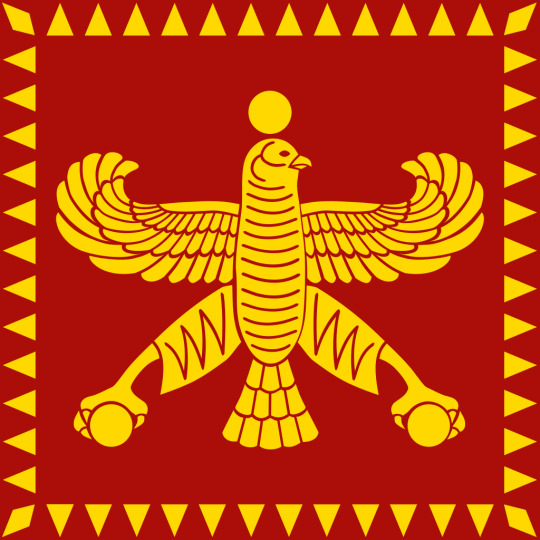
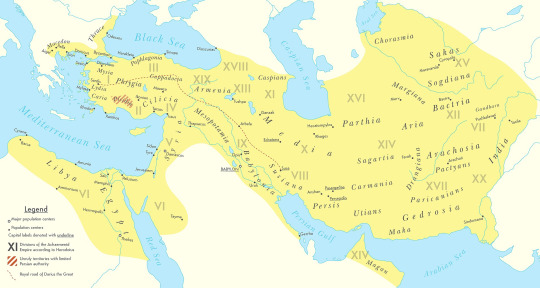


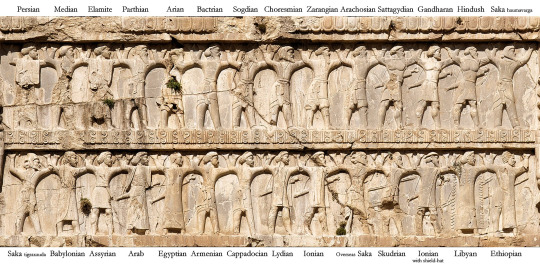
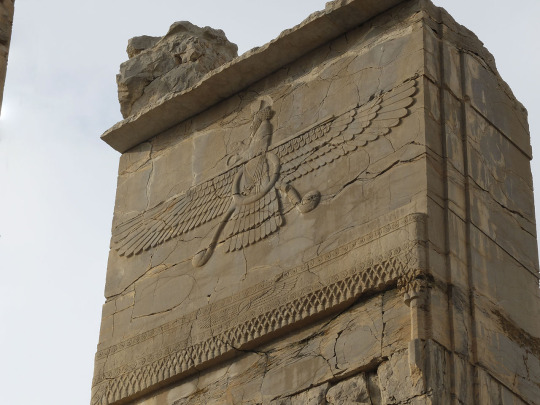




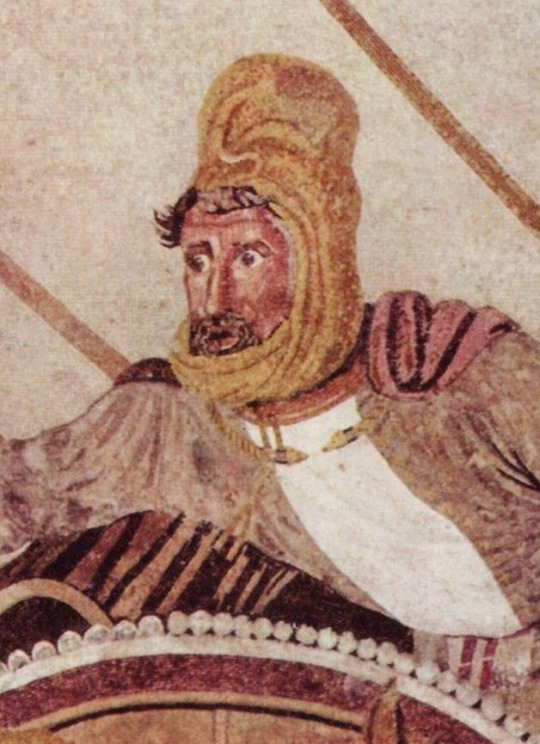
#military history#antiquity#iran#greece#ancient greece#classical greece#ancient ruins#ancient iran#ancient persia#achaemenid#persia#zoroastrianism#alexander the great#cyrus the great#xerxes#artwork#government#history#persian empire#ancient egypt
89 notes
·
View notes
Note
So who are you up against in the race?
It looks like the Absolute Zeros from Blizzaris, The Screaming Queens, Rebel Ducks, Buff Buzzards. A few others I think? I'd have to check the roster again. But it looked like some steep competition. I'm excited.
#dark ace#storm hawks#skyknight of xerxes#storm hawks fandom#skyknight#atmos#skyknight ace#knight of xerxes#ask blog#great race
8 notes
·
View notes
Text
extremely extremely dumb crack fic idea: after the finale of yugioh, zorc has been banished for good, but bakura’s soul is still. kinda just glued to the ring. not entirely because of the inherent evil nature of the millennium items, but moreso because “fuck you guys this ring is mine.” He’s not really bound to it so much as he’s haunting it because it’s his and what kind of thief king gives back the things he’s stolen??
anyways. the millennium items get lost in the finale, so in this version they get lost lost. They didn’t just fall into a hole in the earth, they fell into [???].
Which basically means that, for contrived plot reasons, the millennium ring + the soul of one Feral Bastard Man wind up in the FMA universe. Alchemy is fun, but what about shadow magic???
#yugioh#FMA#fullmetal alchemist#thinking about this for several reasons#one: there's an immediate point of connection between him + alphonse because they are BOTH ''souls glued to metal'' as barry puts it#two: he would have a fun connection with GREED due to A: them both being thieving bastard men and B: he ALSO thinks being a ghost is neat#three: he would have. EXTREME opinions. on ishval. and xerxes. and everything father is doing.#he is an evil unrepentant feral thieving bastard man who once tried to end the world BT HE WILL NOT STAND FOR KUL-ELNA Mk2!!!#also he would IMMEDIATELY suspect the genocide of ishval for what it actually is beccause *he has already lived it*#anyways. give the cursed jewelry to ed. or al. or greed. or ling. or greeling. or scar. it'll be GREAT.#i know i called this a dumb crack fic at the start but then i started writing these tags and. hey. i accidentally intrigued myself.#what IF bakura...??
7 notes
·
View notes
Text
i think that kunikida is just reim with elliot's anger issues
#i would like to see elliot and kunikida in the same room. i would like to see i#reim and kunikida would get along great i know this. kunikida would attempt to fight xerx within seconds of an introduction#bsd#pandora hearts#kunikida doppo#reim lunettes#elliot nightray
9 notes
·
View notes
Note
sleepover saturday talk about your biggest beef during any music rehearsals
anytime my instrument decides to go out of adjustment in the middle of a fucking rehearsal. last year a bridge pad fell off right before the fucking solo in tchaik 1 and NOTHING would speak whatsoever. fucking half a millimeter thick piece of cork ruined my entire night. or that time i had to play english horn on romeo & juliet overture and they gave me an instrument with a massive crack in the top joint. like what exactly do you expect me to do with this? hum my part?
UH but actually most of my shittiest memories in music rehearsals were from student music directing the shows at my high school. because when you're the only kid in the school who can play piano well enough to accompany an entire show's rehearsal process you get put in charge of running shit in 10th grade. but also when you're in 10th grade literally nobody respects you, including your classmates, so even when the actual directors tell everyone to listen to you when you're running the music rehearsals and trying to teach the ensemble their parts, fucking nobody pays attention, and you waste 10 hours of your life every week for three months wondering why you subject yourself to this bullshit every year
and the show/music was never worth it either lol. like i wasted so much of my life on fucking hairspray. never doing that again! call me when there's an oboe part or don't call me at all
[ask meme]
#the one year. i got to play oboe in pit.#literally my favorite show ive done lol#because i just had to fucking show up and play my part. and then leave.#no bullshit with the cast or crew no trying to get people to listen to me. it was great#im still mad i havent gotten to play oboe in pit again since then!#if xerxes in the spring doesnt come thru for me im throwing shit through the windows i swear#in general rehearsals for stuff in college has been. so much better than high school#because like 95% of the time in college people actually WANT to be there. so they actually like. pay attention. and try#i still want to strangle my high school choirmates for all the time they wasted and the constant disrespect to the director#i miss college chamber choir..............it got killed by covid :/ but it was so fun for the like. 3/4s of a school year i was in it#sasha answers#sleepover saturday#ask meme#outofmydreamsmp3#ty#OH i get pissy at the rehearsals for my shows this year and the last too#but only when people are deliberately goofing off/pulling pranks DURING TECH WEEK#like the show is in two days and this is the night you choose to harass the director with a stuffed bird puppet?#take it down a few dozens notches bud.#otherwise theyre fun. i just turn into the worlds biggest hardass when it's tech week
6 notes
·
View notes
Text
The 2500-year-old Cube of Zoroaster To Stay Shaken But Not Stirred | Ancient Origins
https://www.ancient-origins.net/news-history-archaeology/cube-zoroaster-0011382
View On WordPress
#&039;Ka&039;be-ye Zartosht#14th century#Achaemenid Empire#Alexander the Great#Cube of Zoroaster#Darius II#Elamites#Emperor Darius I#Fire#Fire Altar#Fire Temple#India#Iran#Naqsh-e Rostam#Necropolis#Pasargadae#Persepolis#Persian Empire#Sassanian Empire#UNESCO#World Heritage Site#Xerxes II#Zoroaster#Zoroastrianism#Zoroastrians
0 notes
Text
The Fake Texts of Ancient Greek 'Historians': the Behistun Inscription, Ctesias, Diodorus Siculus, Darius I the Great, and Semiramis
In a previous article published under the title 'Aristotle as Historical Forgery, the Western World’s Fake History & Rotten Foundations, and Prof. Jin Canrong’s Astute Comments', I wholeheartedly supported the position taken by the prominent Chinese Prof. Jin Canrong about Aristotle and I explained why Aristotle never existed as he is known today and most of his texts were not written by him, but by the pseudo-Christian Benedictine monks of Western Europe for the purpose of the ferocious imperial and theological battle that Rome carried out against New Rome-Constantinople and the Eastern Roman Empire. You can find the table of contents and a link to the publication at the end of the present article.

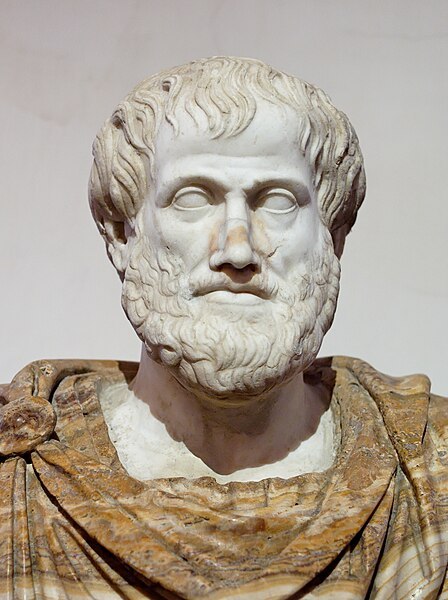
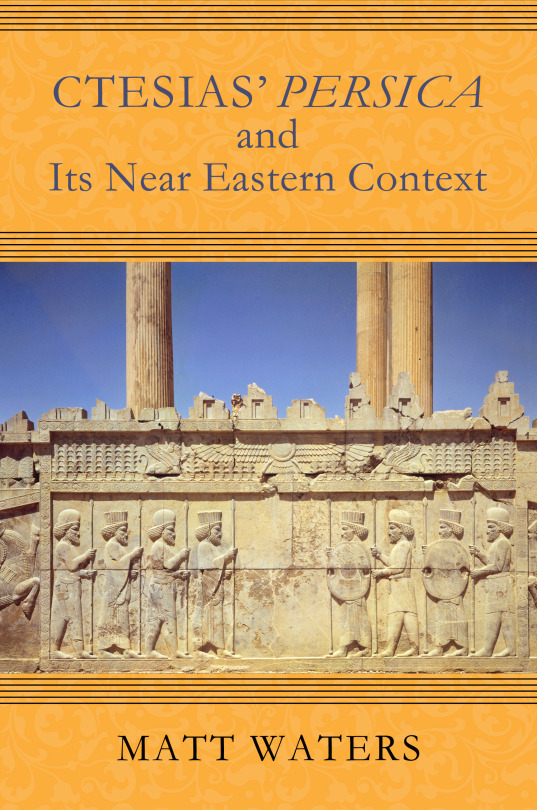
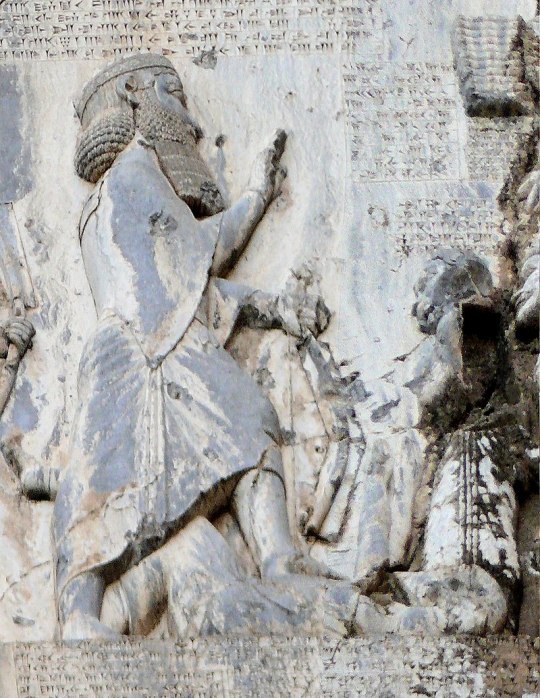
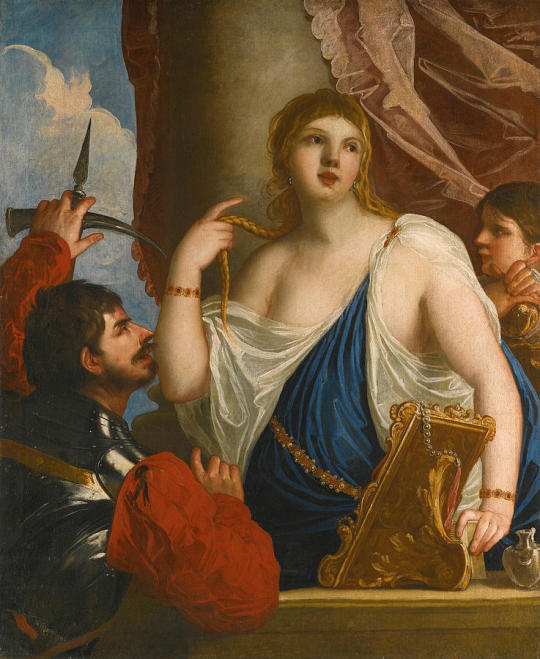
Contents
Introduction
I. A fictional concept: the origin of the fraud
II. A construct based on posterior textual sources
III. The deceitful presentation
IV. 5th century BCE texts found in 15th c. CE manuscripts do not make 'History'.
V. Abundant evidence of lies and deliberate distortions attested in the manuscript transmission
VI. Darius I the Great, the Behistun inscription, and Ctesias
VII. The historical Assyrian Queen Shammuramat and the fictional Queen Semiramis of the 'Ancient Greek sources'
VIII. The malignant intentions of the Benedictine liars: from the historical Darius I the Great to the fictional Semiramis
IX. The vicious distortions of the Benedictine liars: from Ctesias to Herodotus
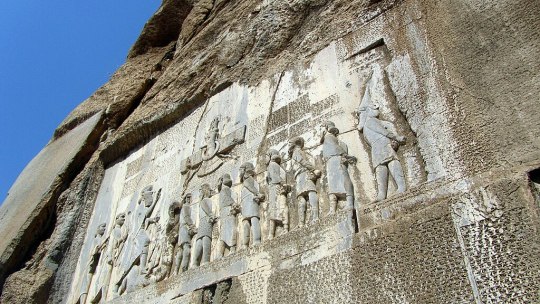
The Behistun inscription
Introduction
In the present article, I will offer a typical example of text falsification carried out by the Catholic monks, who did not 'copy and preserve' manuscripts of ancient Greek and Latin texts, as it has been mendaciously said by Western European and North American academics and lying scholars, but they purposefully falsified, distorted, concealed, destroyed and/or contrived numerous texts.
This enormous forgery took place in Western Europe between the 2nd half of the 8th century and the 1st half of the 15th century; the colonial era was launched exactly afterwards. For this reason, few manuscripts with Ancient Greek and Roman texts date before the 8th c.; in fact, most of them have been either distorted and replaced or hidden in the vast libraries still owned, controlled and administered that the anti-Christian Roman Catholic Church.
The purpose of this devious and evil effort was the fabrication of a fake narrative about the forged antiquity and the supposed importance of the Western Europeans according to the needs of world conquest, prevalence and preponderance of the pseudo-Christian Roman Catholic Church; this bogus-historical dogma, as direct opposition to and ultimate rejection of Orthodox Christianity, would be initially imposed as the 'scientific discipline of History' in Western Europe and subsequently projected onto the rest of the world by means of colonial invasion, indigenous identity destruction, moral integrity demolition, cultural heritage disintegration, educational subordination, economic exploitation, military subjugation, and socio-political domination.
In other words, the monastical scribes and copyists created an entirely fake Euro-centric past, which became the rotten foundation of Western Europe. This fallacy became known as Judeo-Christian world and Greco-Roman civilization. However, the decipherment of ancient languages (Egyptian hieroglyphic, Old Achaemenid Iranian, Assyrian-Babylonian, Sumerian, Hurrian, Hittite, Urartu, Ugaritic, etc) and the study of millions of original texts, which were not copies of earlier sources but contemporaneous to the events that they narrated, sounded the death knell of the era of history fabrication programs.
With the post-Soviet rise of the great continental powers (China, India, Russia, etc.), the economic-military-political-ideological-educational-academic-cultural tyranny of the Western World started being overthrown throughout the earlier colonized world. The historical forgery that the colonial rulers imposed collapsed, the falsehood of the Eurocentric dogma of World History started being revealed and rejected, and an overwhelming project of total de-Westernization appeared as a prerequisite for the liberation of the Mankind from the lies of the European Renaissance, the Western Humanities, the White Supremacism, the Western European colonialism and racism, as well as from the falsehood of numerous subsystems of the construct, such as Classicism, Hellenism, Orientalism, etc.
In our days, it is imperative for anti-colonial scholars to unveil the distortions applied to Ancient Greek and Latin texts by the medieval monks. Consequently, historians from all over the world have to work together in order to denounce and obliterate the Western fraud and the fake History of the Western Man, which consists in arbitrarily taking 14th c. CE manuscripts as authentic narratives of Ancient History.
I. A fictional concept: the origin of the fraud
Apparently, the present brief article cannot be an exhaustive presentation of the Western fraud, and of the historical forgery that the Western monks, manuscript copyists, collectors, academics and propagandists attempted to impose worldwide through colonial conquests, massacres and tyrannies. However, I can still enumerate the major founding myths of the Western World.
Two thematic circles of historical distortions and fraudulent claims made by the Western academia revolve around the following two entirely fabricated entities, which have conventionally but erroneously been called
a) "the Greco-Roman world" and
b) "Biblical Israel" and "Judeo-Christian civilization".
These ahistorical entities never existed. The original concept of those notions is purely fictional, and it therefore remains always unquestioned in the fraudulent Western universities. In this regard, the sources that the Western academics evoke to support their claims are posterior, untrustworthy, forged and therefore worthless.
At times, some of those texts represent merely ancient authors' misperceptions of earlier texts and authors; however, more often, the ancient texts have been tampered with. On other occasions, ancient texts that refute the lies of other historical sources are hidden from the general public and conventionally discussed among the Western academic accomplices.
II. A construct based on posterior textual sources
The entire construct hinges on the deceitful presentation of several types of material forged, collected, concealed, interpreted, contextualized, narrated, repeatedly but intentionally discussed, supposedly questioned, and selectively popularized; this was due to the fact that the said material was incessantly utilized for the colonial needs and targets of the Western European powers (England, France, Holland, Spain, Portugal, and more recently the US). In fact, the Western World's fake History was created as the ultimate support of all colonial claims.
This process happened within a system in which posterior textual sources (preserved in medieval manuscripts) have occupied the central position, whereas the ancient epigraphic material, which was contemporaneous to the historical events under study, has been deliberately disregarded.
All later discovered data and pieces of information were either adjusted to the construct or methodically hidden; this is how the original concept, pathetically believed almost as a religious dogma, remained totally unchallenged down to our days.
III. The deceitful presentation
The quintessence of the deceitful presentation involves a vicious trick; people (pupils and students, but also scholars and intellectuals, as well as the general public) are taught and made accustomed to care mainly about the absolutely insignificant dates of birth and death of historical persons (authors, rulers, etc.), and not about the dates of the manuscripts in which these individuals are mentioned as supposed authors; this situation turns readers, students and scholars into pathetic idiots.
Subsequently, we cannot seriously afford to describe Herodotus as a 5th c. BCE writer, because there is no manuscript with texts attributed to him, dating before the 10th c. CE. In addition, if we take into account the enormous number of other ancient authors decrying, denigrating and rejecting Herodotus' absurdities and malignancy, we have to permanently and irrevocably obliterate Herodotus from the History of Mankind and consider his false, paranoid and racist texts as a double Crime against the Mankind:
first, with respect to the original narrative (to which we don't have access as it was distorted by medieval monastical scribes and copyists) because the author attempted to disparage the superior Iranian civilization and the majestic Achaemenid universalist empire, while undeservedly praising the South Balkan barbarians, and
second, as regards the currently available text, which was forged as per the discriminatory intentions of the monks who altered and distorted it in their effort to fabricate the fake, modern divide (or dichotomy) East-West, and to offer a shred of historicity to it.
IV. 5th century BCE texts found in 15th c. CE manuscripts do not make 'History'.
People get therefore addicted to considering as a true and original 'work' (of an ancient author) the manuscript (or manuscripts) in which the specific treatise, essay or book was copied perhaps 10 or 15 centuries after the author composed it. Due to a long chain of intermediaries (namely library copyists, librarians, scholars, monks, collectors, purchasers and/or statesmen), the transmitted text may have been partly or totally changed.
There is absolutely no guarantee as regards the honesty, the good intentions, the unbiased attitude, and the benevolent character of the perhaps 5, 10, 20 or 50 persons who -living in different eras and without knowing one another- may have constituted the chain of (unknown to us) intermediaries between the hand of the author and that of the last copyist whose manuscript was preserved down to our times.
Example: very little matters today whether the ancient author Diodorus Siculus or Siceliotes (西西里的狄奧多羅斯) actually lived in the 1st c. BCE or in the 3rd c. CE; quite contrarily, what is important for history-writing is the fact that the earliest known manuscript of his famous 'Bibliotheca Historica' (世界史) dates back to the 10th c. CE.
Consequently, the first piece of information that should be stated after the name of any 'ancient' Anatolian, Macedonian, Thracian, Greek, Roman and other author is the date of the earliest extant manuscript of his works.
V. Abundant evidence of lies and deliberate distortions attested in the manuscript transmission
An extraordinarily high number of original sources excavated in Mesopotamia, Egypt, Anatolia, Canaan, Iran and elsewhere, and subsequently deciphered, can be dated with accuracy; example: the Annals of great Assyrian emperor Tiglath-pileser III (745-727 BCE) were written during his reign. They are contemporaneous and therefore original.
However, in striking contrast to them, almost all the manuscripts with the works of ancient Greek and Roman authors whose texts have formed the backbone of the fraudulent historical dogma of the Western academia are not contemporaneous but posterior by, at times, 1500 or 2000 years.
Even worse, numerous ancient Greek authors' texts were not preserved through a manuscript tradition at all; they were saved as references in posterior authors' works. This concerns, for instance, Ctesias (克特西亞斯), an Ancient Carian (Anatolian) physician and erudite scholar, who lived and worked in the court of the Achaemenid Iranian emperor Artaxerxes II in the 5th c. BCE.
Later, willing to offer potential guidebooks to Iran and India for the use of various peripheral peoples and tribes of the Balkan region, Ctesias elaborated in Ancient Ionian (愛奧尼亞希臘語) two treatises to describe the state of things in Iran and in India. To the Western academic bibliography, his works are known (in Latin) as 'Persica' and 'Indica'.
These texts were not saved integrally in manuscripts copied for the purpose of preserving Ctesias' works, but they were preserved in Diodorus Siculus' 'Bibliotheca Historica'. Although he is not known through authentic and contemporaneous Iranian sources, we can deduce that Ctesias certainly spoke fluently the official language of the Empire and read Old Achaemenid cuneiform. Eventually, he may have also studied and learned Babylonian and Elamite cuneiform, namely two ancient Mesopotamian cuneiform languages and writings the use of which was maintained by Iranian scribes.
Apparently, Ctesias had a firsthand insight, as he lived for many years in Parsa (Persepolis), the capital of the Achaemenid Empire and he also traveled extensively along with the Iranian emperor. But, unfortunately, the following ordeal was produced.
VI. Darius I the Great, the Behistun inscription, and Ctesias
One century before Ctesias served Artaxerxes II, the empire of Iran was saved by Darius I the Great (大流士一世; reign: 522-486), who overthrew a usurper, namely the Mithraic (密特拉教祭司) magus Gaumata (高墨达), and by so doing, preserved on the throne a dynasty of faithful Zoroastrian (瑣羅亞斯德教徒) monarchs.
To commemorate his great victory and the consolidation of the his dynasty, Darius I the Great had an enormous rock relief and a monumental inscription (貝希斯敦銘文) engraved on the rocks of Mount Behistun (貝希斯頓山), at a distance of 150 km west of Hamadan (哈马丹; Ekbatana/埃克巴坦那) in Western Iran (15 m high by 25 m wide and 100 m up the cliff). As it can be easily understood, these events occurred after the assassination of Cambyses, at the very beginning of Darius I the Great's reign.
It goes without saying that the successors of Darius I the Great and the imperial Iranian administration knew perfectly well the historical details and were fully aware of the imperial inscription that immortalized the event, which had obviously become the cornerstone of the imperial education.
VII. The historical Assyrian Queen Shammuramat and the fictional Queen Semiramis of the 'Ancient Greek sources'
However, one century later, when Ctesias lived in Iran, served the Iranian Emperor, and spoke Old Achaemenid Iranian (and if not, he was surrounded by the Empire's top interpreters and advisers), something disastrously odd 'happened'.
According to Diodorus Siculus, who explicitly stated that he extensively quoted from Ctesias' text (Bibliotheca Historica, II 13), the imperial Carian physician and author appears to have attributed the Behistun inscription and the rock reliefs to none else than the Assyrian Queen Shammuramat (薩穆-拉瑪特), who was the queen consort of the Assyrian Emperor Shamshi Adad V (沙姆什·阿達德五世; reign: 824-811) and co-regent (811-805) during the first years of reign of her son Adad Nirari III (阿达德尼拉里三世; reign: 811-783)!
Furthermore, in the 'Ancient Greek' text of Diodorus Siculus, the monumental inscription was said to be written in Assyrian cuneiform (Συρίοις γράμμασιν)! Even worse, in the same text (as preserved today), it was also stated that, in the rock relief, there was also a representation of the Assyrian queen!
Ctesias' text, as preserved by Diodorus Siculus, is truly abundant in information, but it is historically impossible and therefore entirely forged. Due to this and many other texts, an enormous chasm was unnecessarily formed between
a) the historical queen Shammuramat of Assyria, whose historicity is firmly undeniable, due to the existence of several contemporaneous cuneiform sources excavated in Assyria, and subsequently deciphered and published,
and
b) the purely fictional Assyrian queen Semiramis (沙米拉姆) of the posterior Ancient Greek textual sources that were supposedly 'preserved' (but in reality deliberately distorted and forged) in the Benedictine manuscripts of Western Europe's monasteries.
However, if we examine closely the facts, we will surely understand what truly occurred in this case; then, we will be able to fathom how the fake History of the Western world was fabricated.
The Behistun inscription is trilingual, as it was written in Old Achaemenid Iranian (the earliest form of written Iranian languages), Babylonian, and Elamite; this was a very common practice during the Achaemenid times (550-330 BCE). The main figure of the associated rock relief is Darius I the Great, evidently the representation of a male royal.
One way or another, with respect to the Behistun inscription and rock relief, Ctesias certainly knew everything that we know today after the successive decipherments of the Old Achaemenid, Babylonian and Elamite cuneiform writings, or perhaps even more, due to the then extant oral tradition.
VIII. The malignant intentions of the Benedictine liars: from the historical Darius I the Great to the fictional Semiramis
The Behistun inscription is not Assyrian; the representation is not that of female royal; and the monument is totally unrelated to Shammuramat, who had lived 300 years before Darius I the Great and 400 years before Artaxerxes II's physician Ctesias. More importantly, by that time, the Assyrian Empire did not occupy the lands surrounding Behistun. Accompanied by Iranian imperial officers and his associates, Ctesias certainly learned all the details of the monumental inscription that we can now read in articles, courses, lectures, books and encyclopedias.
The narrative was a triumph for Darius I the Great and a spectacular rebuttal of the vicious Mithraic Magi who had supported the defeated evil sorcerer and villain Gaumata. Apparently, writing a guidebook for Iran to help marginal people of the Empire's Balkan periphery, Ctesias did not have any reason to say lies. Moreover, we don't have any reason to believe that Diodorus Siculus needed to distort the truth to that extent, when copying and thus preserving Ctesias' masterpiece for the posterity.
However, the transmission of the details about the Behistun inscription embarrassed the Benedictine copyists who wanted to denigrate Darius I the Great and to portray his great empire in a most derogatory manner. They had already proceeded in this manner, distorting other manuscripts, forging texts, and fabricating their pseudo-historical narratives at will.
That is why Ctesias' pertinent text, which had certainly been preserved in its original form within Diodorus Siculus' Bibliotheca Historica, was intentionally distorted by the Benedictine 'Holy Inquisition of Libraries', which fabricated the myths of today's Western world some time after the middle of the 8th c. CE. To be accurate, Ctesias' historical description was entirely replaced by a fictional and historically nonsensical account.
The unbelievable lies -invented and included in Diodorus Siculus' quotations from Ctesias- risked making of the fictional queen Semiramis a world ruler! Whereas the Assyrian Empire at the end of the 9th c. BCE did not control even the western half of today's Iranian territory, the unequivocally mythicized Semiramis had supposedly sent her armies up to India where those fictitious Assyrian soldiers were trampled by the elephants. This worthless narrative that replaced Ctesias' original text may very well have been invented as a 'historical' excuse for Alexander the Great's failure to advance deep inside India.
IX. The vicious distortions of the Benedictine liars: from Ctesias to Herodotus
But if the fictional Semiramis' Indian campaign is entirely false, so are then the preposterous narratives of Herodotus about Darius I the Great's and Xerxes I the Great's campaigns in the insignificant and barbarian circumference of South Balkans. These texts involved evil purposes, heinous anti-Iranian biases, fictional battles, racist discourses, vicious lies, incredibly large number of the Iranian armies, and absurdly high number of Iranian casualties.
The mendacious but idiotic Benedictine monks, who wrote those slander tales did not apparently expect that, sometime in the future, excavations would bring to light splendid Iranian antiquities, original cuneiform documentation, and trustworthy contemporaneous historical sources, whereas a systematic effort of decipherment would offer to people all over the world direct access to historical texts written in dead languages, thus irrevocably canceling Herodotus' nonsensical report and, even more importantly, the later distortions that the Benedictine monks made on their worthless manuscripts.
In any case, had those fictional campaigns against 'Greece' had a shred of truth to them, they would have certainly been documented one way or another in various Old Achaemenid, Babylonian, Elamite, Imperial Aramaic, Egyptian hieroglyphic or other sources; but they were not.
Even worse, the meaningless and ludicrous battles of Marathon, Thermopylae, Salamis, and their likes would have been commemorated by the Seleucids, the Ptolemies, and the Attalids all the way down to the Romans and the Eastern Romans. But we know quite well that the nonexistent, fictional past of the so-called Ancient Greek world was absolutely irrelevant to them: precisely because it had not yet been fabricated.
===================
Aristotle as Historical Forgery, the Western World’s Fake History & Rotten Foundations, and Prof. Jin Canrong’s Astute Comments
Contents
I. Aristotle: a Major Founding Myth of the Western World
II. When, where and by whom was the Myth of Aristotle fabricated?
III. The Myth of Aristotle and its first Byproducts: Scholasticism, East-West Schism, the Crusades & the Sack of Constantinople (1204)
IV. Aristotelization: First Stage of the Westernization and the Colonization of the World
V. Aristotelization as Foundation of all the Western Forgeries: the so-called Judeo-Christian Heritage and the Fraud of Greco-Roman Civilization
VI. The Modern Western World as Disruption of History
VII. The Myth of Aristotle and the Monstrosity of Western Colonialism
======================
Download the article in PDF:
#Ctesias#Diodorus Siculus#Behistun Inscription#iran#Achaemenid#Behistun#Bisotun#Darius I the Great#Gaumata#Mithraism#Zoroastrianism#Ahura Mazda#Mithra#Xerxes I#Herodotus#Ancient Greeks#manuscript transmission#Shamshi Adad V#Adad Nirari III#Shammuramat#Semiramis#Benedictines#Renaissance#Classicism#Classics#Orientalism#Hellenism
1 note
·
View note
Text
part one of the roster !!!!!!! dont ask how many of these i'm going to need because not even i know. 1/???
#ashaf — lay my curses out to rest.#angela anne huell — the eternal witch.#dunward l. colvect — a fallen king wears no crown.#oscar orlencia — here comes the sun ; descending from the great.#phanora kristoffel — adorned in ice ; rising like the dead.#anya forger — telepathic toddler.#becky blackbell — it's a rich kid's world.#damian desmond — an unloved boy who seeks a mother's love.#loid forger — the embrace of twilight protects you.#yor forger — every rose has its thorns.#ada vessalius — disciplined sister.#echo baskerville — je suis à vous.#noise baskerville — je suis en amour.#lacie baskerville — we were there in everlasting bloom.#reim lunettes — a false death & the pull of a trigger.#sharon rainsworth — roses bloom for the youngest heiress.#xerxes break — then a mad heart will stain everything.
0 notes
Note
I want to say I absolutely love your swap AU! I am super curious on how your thought process goes on stuff like making Michael's last name Xerxes, your iteration of Eve/Roo, and Emily as she seems influenced a lot by Michael being a lion.
THANK YOU!!
I've always seen my version of Michael as a lion, the most powerful person after God, like the king of the jungle, and his design was inspired by lions, for example, his hair is like a lion's mane.
And Xerxes means: meaning "great warrior" or "lion-king." In the bible, Noble and great, Xerxes means "monarch, brave, strong," and "ruler of heroes"
And since he was the king of hell when he fell, it made sense to make him a lion. In Eve/Roo's design, I generally took trees as a model, for example, the furs on her coat are like leaves, her horns are like roots, almost half of her body is also like a tree.
The reason why Emily has lion traits because of her father. in general, Emily is like her father, very kind and kind-hearted, just like Michael before the fall.


#hazbin hotel#hazbin hotel fanart#hazbin hotel michael#hazbin hotel emily#hazbin hotel eve#hazbin hotel roo#hazbin hotel au
288 notes
·
View notes
Text
STORIES TELLING: NED LOWE AND THE DEATH OF POOR REPRESENTATION IN OUR FLAG MEANS DEATH
In history, Ned Lowe was one of the most sadistic and violent pirates in the early 18th century, so he’s an obvious choice for a villain for season 2, episode 6 – Calypso’s Birthday. What is interesting is what the OFMD writers chose to do with him.
Lowe announces himself to the crew of the Revenge with great fanfare (cannon ball attack) and gets right to the point.

Ed is thoroughly unimpressed.

Cut to Ed and Stede tied up while Ned attempts to set the mood so he can monologue about why he wants to kill Ed.




Ed knows what’s coming. He is going to suffer but he still can’t be arsed to meet Ned with anything but vaguely bored dismissiveness (and Stede is happy to play along).

Up on the deck, Ned prepares the crew for his big, dramatic moment of symphonic torture.
Note that the Revenge crew is tied down, braced by vices and generally unable to protect themselves from imminent torture and possible death, but their spirits are up. They don’t seem terribly fussed.
Then Stede uses his people positive management style to happily orchestrate a worker uprising in Ned’s crew.
Ned’s crew responds instantly; severing their allegiance to Lowe and telling him off.

The crew sails away and talks profit sharing while Ned dully threatens to hunt them down.
Ned is now a prisoner of the Revenge crew and seems entirely disinterested in his own survival.


And Ned sinks to the depths, without struggling at all.

There is a lot going on in this episode: pay and labor equity direct action, gay love engagement bliss, kink humor, Stede being a hero and saving his crew by playing to his strengths, then having to decide whether to kill in cold blood and feel the consequences of that choice. Ed having one more reason to be done with piracy (while being so impressed with and fond of Stede), and then watching his man make a fraught choice and having to deal with the fallout from that. (And, damn, I haven’t even mentioned the passionate sex bit.) Anyway, back to the point.
Now for the the meta part
The Ned Lowe sequences are perfectly in keeping with OFMD’s signature blend of madcap violence, humor, and big emotional gut punches. But something about Ned Lowe just strikes me as off for this show.
Ned is seriously threatening the crews’ lives, so why don’t they take him seriously?
Why does Ned have such a boring, throwaway backstory?
Why is Ned so nonchalant about his own death; like it’s a foregone conclusion?
Why does Ned have a silver violin and silver spurs on his slip-on dress shoes?
Why is Ned sartorially monochromatic?
And then I realized who Ned reminds me of.
This guy,

Earnst Stavro Blofeld in the James Bond film Diamonds are Forever (1971)
And this guy,

Scar in Disney's The Lion King (1994).
And this guy,

Xerxes, 300 (2006).
And it sure seems like Ned Lowe isn’t just an episodic villain. He is an archetype of the one-dimensional, stereotypical queer-coded villain that has been endemic in film and television throughout history. The OFMD writers have a lot to say about what to do with this kind of character:
Don’t respect him.
Feel free to openly mock him.
Don’t let him take your joy, even though he will hurt you.
He won’t disappear on his own. You have to throw something at him (take action) to make him go away.
Once he’s in the water, he’s content to drown. He’s not into what he’s doing any more than you are.
Oh and, just to be clear,

The LGBTQIA+ community has a very long history of turning shit media into better stories. So, hey, big media, prepare to have your crap characters wrecked (improved).
Now, back to our transformative pirate show with rich, complex queer characters and a multi-layered plot that surprises me every week and makes me feel big feelings - most of all, joy.
Final thought: I do wonder if Ned Lowe is monochromatically silver as a tribute to/poke at, Hollywood and the silver screen.
This meta was written before OFMD season 2 has fully aired. No idea what’s going to happen in the finale (and I’ve generally fled social media to avoid spoilers). I’ll be back, looking at everyone’s fascinating posts after episode 8 airs.
#JFC the OFMD writers have game#OFMD writers do not like stereotypes and know what to do about it#One-dimensional stereotypical queer-coded villains#OFMD meta#Ned Lowe#Thank you David Jenkins#Thank you Alyssa Lane#Thank you Alex Sherman#Thank you Eliza Jimenez Cossio#Thank you Zarye Ferrer#Thank you William Meney#Thank you John Mahone#Thank you Jess Tom#Thank You Natalie Torres#Thank you Simone Nathan#Thank you Adam Stein#Thank you Yvonne Zima#Thank you pocket friends for being awesome and keeping me curious and inspired#Our flag means death#OFMD S2 E6#Calypso’s Birthday#OFMD S2 spoilers#OFMD S2 E6 spoilers
720 notes
·
View notes
Photo

(18/54) “The king threw a celebration on the 2500th anniversary of the Persian monarchy. It was the largest gathering of world leaders in history. He constructed a city of tents around the ruins of Persepolis, where Cyrus’s grandson Xerxes ruled the ancient world. 1500 cypress trees were planted in the middle of the desert. There were vast carpets of petunias and marigolds. The king opened the ceremony with a speech at the tomb of Cyrus The Great. As he spoke, his voice shook with emotion. He said: ‘Rest in peace, for we are awake. In a troubled world, Iran still bears the message of freedom and humanity. Even in the darkest times, the torch thou lit has never died.’ The king was at the height of his power. Oil prices were at record highs. With each passing year Iran grew wealthier and wealthier, and the king gathered more power into his hands. Every New Year I would gather the children together and read from Shahnameh about the story of Jamshid, the fourth king of Iran. Jamshid was the greatest king. The wisest king. The Iranian people gathered around him in adoration, and built him a throne of sapphires, emeralds, and rubies. He taught men to build buildings. He taught men to heal the sick. He unlocked all the secrets of the world. And his throne began to float into the air. With each new gift to the people, it rose higher. And higher. And higher. Until one day it rose too high. Jamshid lost touch with the people. He could no longer hear their voice. He no longer wanted their participation. He gathered his advisors around him, and announced: ‘All good things come from me. I am the maker of the world.’ As soon as he spoke these words, his throne began to fall. With tears of blood he begged for pardon, but none was given. And the dread of coming darkness was his lot.”
سال ۱۹۷۱ شاه جشن ۲۵۰۰ سالگی شاهنشاهی ایران را برگزار کرد. این جشن بزرگترین گردهمآیی سران دولتهای جهان در تاریخ بود. شهری از چادرها پیرامون بازماندههای تخت جمشید بر پا شد، جایی که نوهی کوروش بزرگ بر دنیای باستان فرمان میراند. ۱۵۰۰ درخت سرو در میانهی دشت کاشتند. همراه با فرشهای پهناوری از گلهای اطلسی و همیشهبهار. شاه با سخنرانی در کنار آرامگاه کوروش بزرگ مراسم را آغاز کرد. صدایش از سنگینی آن لحظهها لرزان بود. او گفت: «کوروش، آسوده بخواب زیرا که ما بیداریم. و برای نگاهبانی میراث پرافتخار تو همواره بیدار خواهیم بود. ایران در پهنهی پرآشوب جهان پیامآور آزادگی و مردمی و پاسدار والاترین آرمانهای انسانیست. ای کوروش، مشعلی که تو افروختی هرگز خاموش نشده است. ایران نگهبان پیام آزادی و مردمی در این جهان پر آشوب است، حتا در تاریکترین لحظهها.» در آن زمان شاه در اوج قدرت بود. بهای نفت به بالاترین حد رسیده بود. با گذشت هرسال بر داراییهای کشور و قدرت شاه افزوده میشد. هر سال نوروز، برای بچهها داستان جمشید - چهارمین پادشاه ایران - را میخواندم. جمشید پادشاه بزرگ آفرینش و سازندگیست. پادشاهی خردمند است. ایرانیان ستایشکنان پیرامون او گرد آمدند و تختی از یاقوت کبود، زمرد و یاقوت سرخ برایش ساختند. جمشید از رازهای جهان پرده برداشت. ساختمانسازی را به مردم آموخت. دارو و درمان بیماریها را، نوشتن و بویهای خوش را، هرآنچه به کار زندگی شاد و آسوده بینجامد، پنهان نماند. خرد او بر همه هویدا بود. فره او چندان درخشان بود که تخت او به آسمان فرا رفت و ارجش با هر خدمت تازه به مردم فرا و فراتر رفت. غرورش چندان اوج گرفت که بزرگان کشور را فراخواند و گفت: چنین گفت با سالخورده مهان / که جز خویشتن را ندانم جهان / چو من نامور تخت شاهی ندید / جهان را به خوبی من آراستم / چنان است گیتی کجا خواستم. با راندن این سخنان بر زبان پیوندش با مردم گسست ،فرهاش فروکاست. بختش رخت بربست. با اشکهای خونین خواستار بخشایش شد، نابخشوده ماند. فرجامش دلشکار است
142 notes
·
View notes
Note
Good luck with the race! Careful who you buy spare parts from
Ha! Thanks!
I have been told by Stork that we will not be buying any spare parts. He will make anything if we need it.
Paranoia and all that you know?
#dark ace#storm hawks#skyknight of xerxes#storm hawks fandom#skyknight#atmos#skyknight ace#knight of xerxes#ask blog#great race#stork#storm hawks stork
4 notes
·
View notes
Text

Profiles in Villainy
Lust
Thousands of years ago there was a brilliant alchemist named Van Hohenheim who created a powerful Homunculus that gained sentience. This Homunculus would go on to be known as Father. This Father created a powerful alchemic spell that killed the entire population of ancient civilization of Xerxes. The countless souls of those killed were then sealed within seven Philosopher Stones which Father mixed with the blood of Hohenheim to create seven Homunculi. Father named each his creations after the seven deadly sins of the Old Testament. Father and his Sins then waged a war of terror for years, secretly manipulating the course of mankind whilst further garnering power and influence.
Lust is one of these dangerous Homunculi. Along with being a tremendously skilled combatant, she has the ability to cloud opponents’ minds with overwhelming feelings of desire. She maintained a great disdain toward humans, seeing them as frail, predictable, and generally foolish. Moreover, she would often comment on the ridiculousness of human nature. As such she felt no remorse over her actions, gleefully watching the village of Liore fall into chaos and civil war.
Actresses Yûko Satô and Kikuko Inoue each provided the voice for Lust in the anime (with actress Laura Bailey voicing the character in the English dub). The villainess first appeared in the first episode of the Fullmetal Alchemist: Brotherhood anime, airing on April 5th, 2009.
#Profiles in Villainy#Fullmetal Alchemist#Lust#Fullmetal Alchemist: Brotherhood#cut-out#paper art#Villains!
114 notes
·
View notes